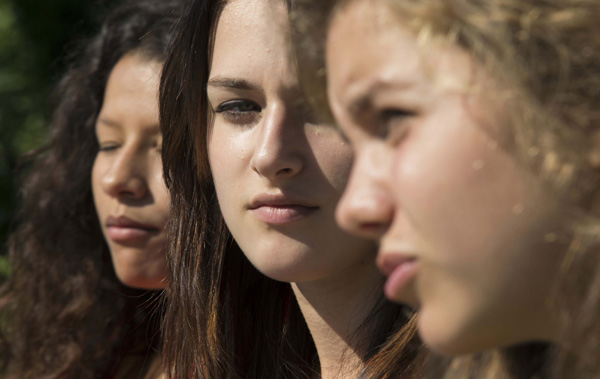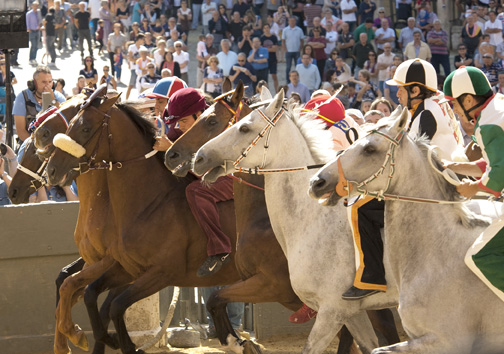In general, documentaries tend to be the strength of the Tribeca Film Festival’s programming, and though there are many solid narrative films in this year’s edition, the nonfiction films take viewers on journeys that not only spanned the globe but also scrutinize many aspects of the human experience.
Adolescence is explored in depth in a variety of films, most notably in The Wolfpack, a standout work. The premise sounds eerie: a family of teenage boys (and their younger sister) is essentially held hostage for their entire lives. The paterfamilias isn’t so much a father as a cult leader wannabe who rarely lets the children, or their mother, leave their apartment on New York’s Lower East Side. The boys eventually revolt, and the filmmaker are on hand to document their slow emergence from the cocoonlike prison of their crumbling apartment into the outside world.
The teenage years are a fight for survival, too, for the protagonists of the French drama Being 14. Debut director Hélène Zimmer employs documentary-style camera work for a warts-and-all portrayal of three French teenage girls during their last year of middle school: the sullen and volatile Sarah (Athalia Routier, channeling a young Kristen Stewart); the seemingly sophisticated Louise (Najaa Bensaid); and the sad-eyed, vulnerable Jade (Galatéa Bellugi). Loose in structure, with an almost nonexistent plot, the film focuses on several key moments during the course of the year.
As the exam that will determine which high school the girls attend (and, in a very real sense, their destinies) looms, they take part in well-worn adolescent rituals: alcohol-saturated parties, hook-ups, screaming matches with parents, and cutthroat bullying that makes the Burn Book of Mean Girls look like mild teasing. Jade bears the brunt of the bullying, and Bellugi’s quietly moving performance is wonderful. Indeed, all of these young actresses are pitch-perfect.
Out of the mouths of these babes come frank talk about sex and swearing galore, but there’s little here that will surprise even the most wide-eyed of viewers. Compared with the likes of Larry Clark’s Kids or Catherine Hardwicke’s Thirteen, Being 14 is fairly button-down. Though this isn’t a film that breaks new ground, it effectively conveys what it feels like to be a 14-year-old girl. For all of their posturing and jockeying, it’s apparent that the teens aren’t nearly as confident or self-assured as they’re desperately trying to be. The portrayals are tinged by an underlying sense of sadness and uncertainty; this tone distinguishes the film—and will keep viewers curious to see more of what first-time director Zimmer has to offer.
With Toto and His Sisters, we move from the suburbs of France to the slums of Bucharest. This stark documentary about six-year-old Toto and his older sisters, Andreea (14) and Ana (17), who are attempting to get by while their mother serves time for drug trafficking, makes the issues faced by the girls of Being 14 look like, well, First World Problems. Though technically the children are in the care of their mother’s brothers, they’re better off on their own. When their uncles do show up in the kids’ tiny, one-room home, they stay only to shoot heroin and leave a trail of cigarette butts, syringes, and garbage in their wake. It’s clear, too, that Ana’s following her mother and uncles down a dark path, as she’s arrested (though eventually released) for selling heroin. There’s a glimmer of hope here, though only the barest one.
Much as sensitive viewers may object to nature documentarians who keep their cameras trained on a lion as it takes down a gazelle, we marvel, even shudder, at filmmaker Alexander Nanau’s ability to stay objective. It’s hard not to want him to intervene when one sees Toto casually sitting feet away from men shooting up. Refreshingly, the director neither plays up the shock value, nor does he romanticize Ana or Andreea. (Often what is emphasized, through shot after shot of the dingy, one-room apartment, is the sheer monotony of poverty.) Indeed, though these young people’s love for one another is clear, they’re often depicted as self-centered typical teens rather than as noble and indomitable, large-eyed gamines; Les Misérables set in Romania this isn’t. On the whole, this is a harsh and unremitting glimpse at deprivation.
Lightening the mood considerably, the documentaries Palio and GORED are thrilling examinations of ancient and ritualistic blood sports. With Palio, director Cosima Spender takes on the Palio di Siena, held twice each summer in the Tuscan city of Siena. It’s a heart-pounding 90-second horse race filled with twists and turns that often result in pile-ups and falls (indeed, on 23 occasions in the race’s centuries-old history, a riderless horse has won). Rife with corruption and politics (the rampant system of bribery isn’t a damaging influence creeping in; it’s de rigueur at Palio), the race pits districts of Siena against one another. Palio also places its riders in peril that doesn’t end even once it ends: district denizens have been known to beat riders who take pay-offs in favor of a win, and if a rider loses the overall race, beating a rival district can be just as satisfying.
The explanation of the preparations for the race evokes a mix of Shirley Jackson’s “The Lottery” and The Hunger Games: at a much-heralded ceremony, names are drawn, revealing which horse is to be assigned to which district. The film fairly oozes virility and bravado, from the shots of the sweaty, snorting, head-tossing horses to the insults and trash-talking the various riders engage in. Set to an Ennio Morricone–infused soundtrack, the story is exciting, framed expertly.
There’s Gigi Bruschelli, the arrogant yet charismatic front runner horseman, who has accrued his many wins allegedly through his vicelike grip over other riders. And then there’s Giovanni Atzeni, the pure, as yet untainted twentysomething racer motivated not by money but by glory. The film keeps the action coming, and though there are some cringe-inducing injuries depicted, the overall effect is exhilaration and just plain fun. Each fascinating bit of information that Spender doles out will have viewers grabbing their phone and Googling up a storm—and perhaps even ensuring that their next summer includes a stopover in Siena.
Audience members who turn up for Ido Mizrahy’s GORED experience 75 minutes of imminent death in this portrait of famed bullfighter Antonio Barrera. He’s known not for his elegance or strength in the ring but for the far more grotesque title: most gored. The movie uses Barrera’s final fight as a framing device, opening on the performance and then jumping back in time to trace his rise to fame. Barrera’s devotion to his cause borders on the fanatical, even the absurd (he’s often carted out of the ring for medical intervention only to insist on returning to finish the fight). Viewers may be reminded of the over-the-top scene of Whiplash, which sees its single-minded protagonist soldiering on to perform after a devastating car accident.
This is a slower, more contemplative film than Palio, and Barrera often meditates on the concept of death. Unlike Palio, women have a place here (though granted, it’s on the outskirts). The anguished interviews with Barrera’s wife and sister, who have witnessed many of his injuries, add another layer of nuance. While Barrera is bold and charismatic—it will be hard even for consummate animal lovers to dislike him—viewers will come away less with a Hemingway-esque, starry-eyed appreciation for the sport and more a sense of sadness. Barrera’s poverty and his ambitious father’s aspirations are clearly motivators for what would become a career marked by his own physical suffering and the emotional turmoil of those who love him. Pair this one with Palio for an intensely visceral glimpse into blood sport.
Finally, we head for Japan, for Erik Shirai’s The Birth of Saké, which approaches this grain alcohol with the same reverence as Jiro Dreams of Sushi. The film centers on the Yoshida Brewery in northern Japan, where the traditional attitude toward saké will have farm to table fans and artisanal-happy hipsters drooling. Viewers may leave the theater with only a rudimentary grasp of how saké is created; the film is at its core a glimpse into a way of life that’s quickly fading. This brewery, which employs many men in their sixties and seventies who have devoted their lives to their jobs, stands in stark contrast to most companies that manufacture saké—or most any product, for that matter—that emphasize minimizing cost and maximizing profit,
Perhaps unexpectedly, this evocative film has a bit in common with the visceral, high-intensity GORED: the wives of Saké, too, feel the impact of their husbands’ devotion. For six months, to supervise the intense process, the men must give up their personal affairs and live at the brewery full-time. With lingering, often silent shots (some bordering on the obvious, like one focusing on an old man’s weathered hands), this is a slow-paced work that may not appeal to a wider audience, but the discerning viewer will find plenty to savor.



















Leave A Comment